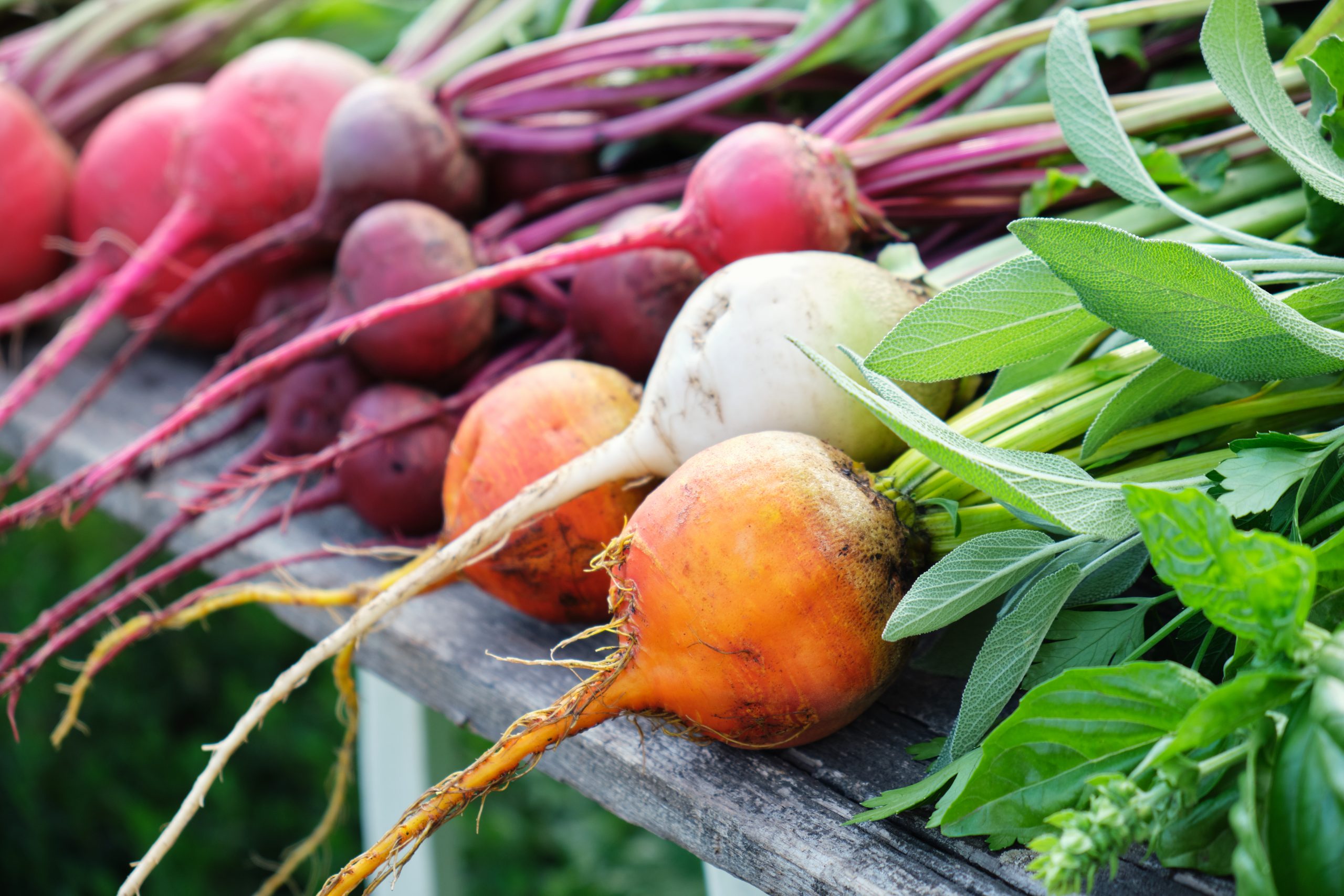Welcome to Blue Book!
Are you ready to join the thousands of companies who rely on Blue Book to drive smarter decisions? View our plans and get started today!
Still have questions? We’d love to show you what Blue Book can do for you. Drop us a line– we’ve been waiting for you.

In this article
Root vegetables are one of the oldest foods cultivated by humans. Since roots, as their name implies, grow underground, they’re easy to cultivate and thrive in a wide range of climates.
Better yet, their function as energy storage for roots means they contain hearty carbohydrates such as starches and sugars.
In some parts of the world, root vegetables far outpace grains and fruits as a food staple. They’re also slower to spoil if kept under the right conditions and rather filling, making them an appealing choice for consumers trying to get the most out of their produce dollars.
North America has a rich history in root vegetables, from the potato crops planted by colonists to the sweet potatoes favored in the South.
They encompass a wide range of vegetables, but the biggest of these crops in the United States and Canada are potatoes, onions, and carrots.
We spoke to industry experts about the state of the root vegetable industry in North America, challenges facing this most durable of produce categories, and what they see as the future of these staples.
Growing and Packing
With their ease of production—many carrots, for example, grow wild in yards and even vacant lots—as well as their consumer appeal and nutritional value, root vegetables can grow in every U.S. state and every province in Canada.
In descending order of overall popularity, the most widely grown crops are potatoes, onions, beets, carrots, sweet potatoes, radishes, turnips, rutabagas, parsnips, and yams—but the places where they grow range from coast to coast and from warm to cool climates.
It’s not surprising California grows the most root vegetables in the United States, leading the pack for several, including onions, carrots, and turnips. Idaho, of course, is well known for its potatoes and even features the vegetables on the state’s license plates.
Sweet potatoes thrive in North Carolina and are the state vegetable, and while Louisiana isn’t the nation’s top producer, the vegetable has appeared on the state’s license plates.
Georgia reigns supreme in sweet onions, where they’re the official state vegetable, while Wisconsin and Michigan grow the most beets, rutabagas, and parsnips. For its part, Florida has recently overtaken the other states in radish production.
In Canada, Ontario has the most production in root vegetables, but Prince Edward Island is as well-known north of the border for potatoes as Idaho is in America.
Other provincial leaders are Alberta, which produces most of the country’s beets, and Quebec, which takes care of having the biggest radish crop.
Production and Shipping
With production of root vegetables ranging far and wide across North America, shipping and transportation still play a key role.
These staples may not be as perishable as fruit, but they still need to get from growers to their destinations. Most is via truck, though rail is favored for some root vegetables.
“We ship by truck and rail and ocean vessel; whatever it takes to get our product where it needs to be.”
Production varies by crop and location, but generally, the growing cycle begins in early spring and concludes just before fall.
Wada Farms (part of Wada Farms Marketing Group, LLC BB #:189555) plants in March and April for a late-summer harvest.
“We ship by truck and rail and ocean vessel,” explains John Vlahandreas from the company’s sales department. “Whatever it takes to get our product where it needs to be,” he adds, noting efficiency and product protection are of equal importance.
Peri & Sons Farms, Inc. BB #:126045 one of the country’s leading onion producers, farms thousands of acres in Nevada and California.
“As a grower, packer, and shipper, all within the United States, our consistent-quality products, sustainable farm practices, Earth-friendly packing options, and highest food safety standards are unmatched,” states marketing director Teri Gibson.
“With everything under one roof, produce buyers can avoid the headaches and pitfalls of ordering through a web of suppliers, distribution channels, and importation challenges,” she adds.
Tools for Transit
Jason Vee, president of distributor Vee’s Produce BB #:138420 in Superior, WI, keeps it simple when it comes to transporting onions and potatoes.
“We ship everything on trucks,” he says. “Our storage onion program is in harvest in Washington and Oregon and our Midwest potato program is also harvesting in Minnesota and Oregon. Overall, I expect a good crop.”
Vee’s Produce recently adopted new technology for shipping in the form of FreightFlow. It came at the suggestion of none other than FreightFlow’s Butch Peri, formerly of Peri & Sons Farms, and a man who knows a bit about onions.
“I needed something that would integrate with our software, and I needed a truck tracking model that drivers would comply with,” explains Vee, noting FreightFlow fit the bill.
“Anything that requires a login or a subscription doesn’t get very good driver compliance,” Vee adds, but says the issue was solved by using a simple texting system.
“FreightFlow sends a text message to drivers giving them three options—on-time, possible delay, or actual delay. Clicking any of these pings the driver’s location. It’s working out great.”
But with an evolving market comes new opportunities and new varieties, many of which are beginning to penetrate what was considered a relatively unexciting marketplace.
Varieties and Demand Levels
Root vegetables may seem like unassuming and simple foods, and in many ways, they are.
But with an evolving market comes new opportunities and new varieties, many of which are beginning to penetrate what was considered a relatively unexciting marketplace.
The ongoing demand for sweet potatoes is spreading far and wide from the South, where they’ve been a mainstay in regional cuisine. Beets, turnips, and rutabagas are faves for roasting with savory sauces, or grilled.
Even radishes seem to be enjoying a renaissance with more acreage devoted to this small pungent or “hot” vegetable.
Another root vegetable, jicama, is gaining recognition of its own. It’s newfound popularity in the United States, due to the country’s expanding Hispanic population, is a prime example of how the sector is changing.
Unassuming jicama has experienced a compound annual growth rate of about 8 percent, which is quite remarkable.
Weather considerations
The availability of root vegetables—and the ability of growers to plant and cultivate new varietals—depends greatly on weather.
“Any farmer will tell you Mother Nature has always had a mind of her own; she’s just gotten more unpredictable,” points out Gibson, citing climate as her company’s biggest challenge. “From hail to frost to drought, climate change and shifting weather patterns are creating uncertainty.
“Any farmer will tell you Mother Nature has always had a mind of her own; she’s just gotten more unpredictable.”
“We rely on our team’s extensive years of farming experience, along with advanced science and technology, to help us make the most of every planted acre.”
Vlahandreas agrees, and his four decades in the root vegetable trade give him a long perspective on climate change’s impact on the industry. “Weather has really had some noticeable changes over the years,” he agrees.
“It seems that we’re getting heat waves during peak growing time now, and strange, wet weather when you don’t really want it.”
Fortunately, he adds, “Harvest time comes in late summer and early fall, so there aren’t as many issues.”
Vee weighs in noting that while there has been some concern about high temperatures in the Northwest over the last season, mature onions can handle heat relatively well.
And as long as the early- and mid-season periods remain normal, there should be little to worry about.
“Some farms are even turning to root vegetables that thrive in tropical climates, such as taro, yacón, and ube, to cope with hotter, wetter conditions,” he points out.
Lending a hand
Another trend has less to do with variety and more to do with time and convenience. Root vegetables continue to find themselves in an ever-expanding array of fresh-cut and value-added products.
Superstars among the category include potato dishes (sliced, diced, seasoned or not), carrots paired with enticing dips, and onions (chopped, alone, or with various other vegetables for stir-frys, grilling, and other entrée ideas).
Vee maintains good relationships with processers in Oregon, Minnesota, and Wisconsin. “Fresh-cut is a different animal than whole produce,” he marvels.
“There’s much more work on the front end, finetuning volume, specs, pricing, cut styles, and temperatures. I have a lot of respect for the people in processing—it’s a difficult business.”
Wada Farms, too, has its eye on new ways of selling established commodities. “Value-added has been increasing more and more every year,” confirms Vlahandreas.
“We seem to live in a grab-and-go society, and with the big-box stores competing with volume sales, it has really trickled down into everyday shopping.
“Not that everything new comes with a guarantee that it’ll work, but if we’re not trying, then we’re not helping ourselves down the road.”
“Processed onions get more attention,” he continues. “When getting ready for a large function, why buy and peel a whole onion when you can buy a peeled or diced onion and cut substantial time off your prep?”
Of course, all products are not created equal or as simple and straightforward as chopped onion, but more ways to save time and effort are generally well received by consumers.
“Not that everything new comes with a guarantee that it’ll work, but if we’re not trying, then we’re not helping ourselves down the road,” observes Vlahandreas.
Organic ideas
Organics have also opened up new possibilities for root vegetable growers, keeping pace with the sector’s current 9.8 percent annual growth rate.
Because root vegetables tend to absorb everything from the soil they’re planted in, they can take on an excessive amount of fungicides, pesticides, and herbicides, making organically grown specimens even more appealing.
“We have organic onions and potatoes available seasonally,” shares Vee, “and the goal is to make this a reliable year-round supply.”
Vlahandreas says Wada Farms works with co-packers on organic products, provided they share the company’s values and are able to focus on the benefits each side of the partnership can bring to the table.
Meeting the Challenges
As we’ve noted, the demand for root vegetables continues to grow.
Older consumers have been eating them for decades while younger generations are learning about them through social media and cooking shows.
This growth is also evident in seed sales. There’s been more than 7 percent annual growth in demand for root vegetable seeds, with more and more chefs are turning to them as a source for nutritious, flavorful, and innovative dishes.
Despite their heartiness and resistance to common challenges, root vegetables can fall prey to the usual rogue’s gallery of produce issues: weather and climate, pests, labor and transportation issues, and sustainability.
Many companies are looking to high-tech tools to meet these challenges, but an overall holistic approach has some looking backwards instead of forwards.
Pests pose a unique challenge because root vegetables are prone to absorbing pesticides, so many growers are turning to more natural methods, like integrated pest management, for control.
Vee’s Produce relies on safety audits from PrimusGFS, one of the leading audit firms in the country, and uses strategically placed and numbered traps as part of its pest control program.
“I still can’t tell if this is a worthwhile pursuit—I hope it is—it’s easier to sell than to produce.“
Eco-friendly measures
Sustainability can be difficult to measure, given that it can only show results in a long-term sense, and this includes packaging.
Vee’s Produce is committed to more sustainable packaging as well, devoting significant resources to completely recyclable and compostable paper potato bags.
“I still can’t tell if this is a worthwhile pursuit; I hope it is,” Vee observes. “It’s easier to sell than to produce. We have to get better at the production end before we take it public.”
Gibson says, “We’re pacesetters for nonplastic packaging in the onion category.”
But better protecting of the planet goes far beyond packaging. Peri & Sons Farms has taken to pushing the envelope of technological limitations as part of their approach as a certified sustainable grower and packer.
The grower has been moving in this direction since 1967, when David Peri’s father received a “Conservationist of the Year” award and continued over the years until its first sustainable farming certification in 2005.
“We have a deeply rooted culture of sustainable farming that took hold long before being Earth-friendly became popular,” Gibson says.
“Over the years, we’ve come to understand that sustainability is not about one big thing; it’s a continuously evolving process,” she explains.
“We’ve been using advanced systems to track and analyze hundreds of metrics across the farm’s operations to provide proven results year over year.”
This includes its equipment and machinery.
“We continue to be early adopters of precision agriculture systems,” notes Gibson, citing Trimble, which offers integrated software, data management, virtual displays, and other technology services, as a keystone to the grower’s approach.
These metrics include data that serves Peri & Sons’ goal of attaining net carbon neutrality, and feed into the grower’s program of process improvement, technological upgrades, building a culture of innovation and experimentation, and achieving employee buy-in to the sustainability goals at every level of the company.
“Onions and potatoes are still relatively inexpensive items. For people trying to fill the grocery cart and stretch their dollars, root vegetables go almost as far as white rice.”
Concluding Thoughts
People have been eating root vegetables all over the globe since the time of antiquity, but they’re only now undergoing a surge in popularity, a spike in production and demand, and a growth in innovation and attention that other fruits and vegetables attained decades ago.
With many new consumers coming to root vegetables for the first time, suppliers and retailers want to make sure they have a good experience.
“Produce is a very competitive business,” notes Gibson. “That’s why we believe our determination to maintain consistent product quality has been essential.
“Prioritizing it helps us to keep costs down by minimizing rejections, questions, and customer complaints,” she adds. “We’re always pushing ourselves to do better.”
Vee offers the last word, emphasizing the simple, humble appeal of root vegetables as well as their affordability and functionality—qualities that have made them the choice for so many communities all over the world for centuries.
“Onions and potatoes are still relatively inexpensive items,” he points out. “For people trying to fill the grocery cart and stretch their dollars, root vegetables go almost as far as white rice.”
This article was originally published in the November/December 2024 edition.








